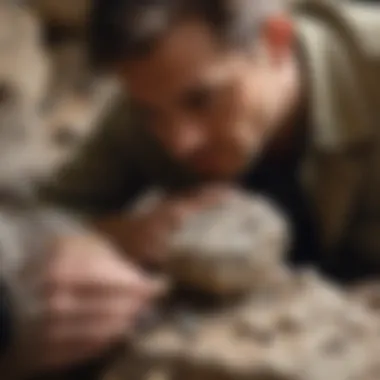Discovering the Ultimate Stone Adhesive: An In-Depth Guide for Rock and Fossil Aficionados


Rock and Fossil Identification
Exploring the best glue for stone requires a fundamental understanding of the types of rocks and fossils involved. In the realm of rock and fossil collecting, it is essential to differentiate between various geological specimens based on their distinct characteristics. Rock enthusiasts often seek a diverse range of rocks, from sedimentary to igneous varieties, each with unique properties and features. Fossil collectors, on the other hand, focus on preserving ancient remains such as bones, shells, or imprints of prehistoric organisms encased in rocks. To accurately identify rocks and fossils, collectors rely on specific tools like magnifying glasses, hardness picks, and UV lights to scrutinize texture, color, mineral content, and other identifying factors.
Introduction
In the realm of rock and fossil collecting, the significance of selecting the most appropriate adhesive for stones cannot be overstated. The success of any preservation or repair work hinges on the adhesive's ability to form a durable and long-lasting bond between various types of stones. By delving into the nuances of glue selection, this comprehensive guide serves as a beacon of knowledge for enthusiasts in this niche field.
Considering the nature of geological treasures, the stakes are high when it comes to using the right glue. The proper adhesive not only ensures the structural integrity of assembled pieces but also plays a pivotal role in maintaining the aesthetic appeal and historical value of the specimens. Building a solid foundation with the right adhesive can spell the difference between a meticulous restoration and a shoddy repair job.
Rock and fossil collectors invest substantial time and effort in acquiring and curating their collections, making it imperative to have a nuanced understanding of the glue's characteristics and application nuances. Just as each stone has a unique story to tell, the adhesive used to hold them together must complement and enhance these narratives. This guide transcends ordinary adhesive considerations, delving into the intricacies of bonding stones to preserve their allure and historical significance.
As we embark on this exploration into the world of adhesives for stones, it is crucial to approach the subject with a keen eye for detail and a thirst for knowledge. By unraveling the complexities involved in glue selection and application, we equip rock and fossil collectors with the essential know-how to elevate their preservation and restoration endeavors to new heights of precision and excellence.
Understanding the Importance of Choosing the Right Glue for Stone
In this meticulous guide aimed at rock and fossil collectors, the significance of selecting the appropriate glue for stone cannot be overstated. The durability and longevity of rock and fossil collections depend heavily on the choice of adhesive. Factors such as the type of stone, its porosity, and the intended use play crucial roles in determining the effectiveness of the bonding process. Understanding these elements is paramount to ensuring the preservation and maintenance of geological treasures. Rock and fossil collectors must pay close attention to these considerations to prevent damage and maintain the integrity of their specimens.
Factors to Consider
Type of Stone
When it comes to choosing the right glue for stone, the type of stone used is a critical factor to consider. Different types of stones have varying characteristics that can impact the bonding process. For instance, porous stones like sandstone or limestone may require a different adhesive approach compared to non-porous stones such as granite or marble. Understanding the properties of the stone being bonded is essential to selecting the most suitable glue for a secure and long-lasting attachment. Each type of stone presents unique challenges and advantages when it comes to adhesive bonding, underscoring the importance of selecting the right glue for the specific type of stone.
Porosity of the Stone
The porosity of the stone is another key consideration when choosing the appropriate glue. Stones with high porosity absorb liquids more readily, which can affect the bonding strength of the adhesive. It is essential to account for the porosity of the stone to prevent potential adhesion issues and ensure a strong bond. Adjusting the application method and adhesive type based on the porosity of the stone is crucial for achieving optimal results in bonding stone surfaces. By understanding how porosity impacts adhesion, rock and fossil collectors can make informed decisions when selecting the right glue for their specimens.
Intended Use
The intended use of the bonded stone also plays a significant role in determining the suitable adhesive. Whether the stone will be displayed indoors or outdoors, subjected to varying temperatures, or require chemical resistance are all factors that influence the choice of glue. For instance, an adhesive that works well for indoor applications may not withstand the harsh conditions of outdoor environments. Rock and fossil collectors must consider the specific requirements of the intended use to select a glue that will provide the necessary durability and resilience. Tailoring the adhesive choice to the intended use ensures that the bond remains strong and reliable over time, meeting the unique demands of different display or storage scenarios.


Top Recommendations for Glue Types Suitable for Stone
When delving into the realm of bonding stone, selecting the most suitable glue is paramount to the success of any project. The adhesive chosen can make a significant difference in the longevity and durability of the bond, especially when dealing with various types of stones. In this comprehensive guide for rock and fossil collectors, we focus on top recommendations for glue types suitable for stone, shedding light on the essential elements that can influence your decision-making process.
Epoxy resin and cyanoacrylate (super glue) stand out as prime choices for bonding various stones due to their unique properties and advantages. Understanding the intricacies of these glue types and how they interact with different stone surfaces is crucial for achieving a secure and lasting bond.
Epoxy Resin
Benefits of Epoxy Resin
Exploring the benefits of epoxy resin unveils a world of advantages for bonding stones. This versatile adhesive offers exceptional strength and durability, ensuring that your geological treasures remain intact for years to come. The key characteristic of epoxy resin lies in its ability to create a strong and resilient bond that can withstand environmental factors and wear over time.
Epoxy resin's exceptional adhesive properties make it a popular choice among rock and fossil collectors seeking reliable solutions for bonding various stones. Its unique feature includes a relatively longer curing time, allowing sufficient flexibility for adjusting the pieces before the bond sets permanently. However, this extended curing period also requires patience and precision during the application process.
Best Practices for Using Epoxy Resin with Stone
When utilizing epoxy resin for bonding stones, adhering to best practices is essential for achieving optimal results. Proper surface preparation, including thorough cleaning and dry-fitting of the pieces, is a fundamental step that sets the foundation for a successful bond. Ensuring that the surfaces are free of debris and contamination is vital for promoting adhesion and maximizing the bond's strength.
An important consideration when working with epoxy resin is the amount of glue to use. Applying an appropriate quantity of adhesive is crucial for creating a strong bond without excess material seeping out from the seams. Additionally, applying pressure while bonding the pieces can help in enhancing the adhesion and ensuring a tight fit between the surfaces.
Cyanoacrylate (Super Glue)
Advantages of Cyanoacrylate
Cyanoacrylate, commonly known as super glue, offers a range of advantages for bonding stone surfaces. Its rapid bonding properties make it a favorite choice for quick repairs and instantaneous bonds. The key characteristic of cyanoacrylate lies in its fast-drying nature, which allows for swift adhesion between stones, making it a convenient option for immediate fixes.
The unique feature of cyanoacrylate is its ability to form a clear and transparent bond, ideal for stones with aesthetic appeal that should not be obscured by visible adhesive. However, it is important to note that while cyanoacrylate offers quick adhesion, it may not provide the same level of durability and strength as epoxy resin over extended periods.
Considerations When Using Cyanoacrylate on Stone
When choosing cyanoacrylate for bonding stones, certain considerations must be taken into account to ensure successful outcomes. Understanding the sensitivity of some stone types to cyanoacrylate and its potential impact on the surface is crucial for avoiding any inadvertent damage. The key characteristic of considering the porosity and composition of the stone before applying cyanoacrylate can help prevent any adverse reactions or staining.


A unique feature of using cyanoacrylate on stones is its instant bonding capability, which demands precise alignment during application, as repositioning after bonding may not be feasible. Additionally, the thin consistency of cyanoacrylate requires careful application to prevent excess glue from running or pooling on the stone surfaces, potentially compromising the aesthetic appearance of the bond.
Application Techniques for Gluing Stone Successfully
In this article, delving into the proper techniques for successfully gluing stones is pivotal for rock and fossil collectors. Understanding the nuances of applying glue to stones can make a significant difference in the preservation and repair of geological specimens. Proper application techniques ensure a strong and lasting bond between stone pieces. By focusing on the specifics of gluing applications, enthusiasts can enhance the longevity and aesthetic appeal of their collections.
Surface Preparation
When considering the application of glue to stones, efficient surface preparation is paramount. This process involves meticulous cleaning of the surfaces to be bonded and dry-fitting the pieces before the actual gluing. Cleaning the surfaces diligently removes any debris, oils, or impurities that could hinder the bonding process. It provides a clean and receptive surface for the glue to adhere to effectively. Dry-fitting the pieces allows collectors to assess how the stones fit together before applying the adhesive, ensuring precision and alignment.
Cleaning the Surfaces
Cleaning the surfaces before gluing is an essential step in ensuring a successful bond. This step involves using specific cleaning agents or methods suitable for the type of stone and the nature of contaminants present. By meticulously cleaning the surfaces, collectors eliminate any substances that could compromise the adhesive's strength. The meticulousness of cleaning the surfaces directly contributes to the overall quality and durability of the bond, safeguarding the integrity of the geological specimens.
Dry-Fitting the Pieces
Dry-fitting the pieces is a practice that involves test-assembling the stones without adhesive. This step allows collectors to make any necessary adjustments to the alignment or fit of the stones before applying the glue. Dry-fitting ensures that the final bond will be strong and seamless, enhancing the overall appearance of the collection. Additionally, this technique minimizes the risk of errors during the gluing process, promoting a meticulous and professional outcome.
Proper Glue Application
In the realm of gluing stones, the manner in which glue is applied significantly influences the strength and durability of the bond. Understanding the optimal amount of glue to use and the importance of applying pressure during bonding are key aspects of achieving successful adherence between stone pieces.
Amount of Glue to Use
Determining the appropriate amount of glue to use is fundamental to a successful bond. Using too little glue may result in weak adhesion, while excessive glue can create a messy and less effective bond. Collectors must strike a balance and apply the right amount of adhesive to ensure a secure and stable connection between the stones. The accuracy in applying the correct amount of glue enhances the overall quality and longevity of the bond, maximizing the preservation of the geological specimens.
Applying Pressure While Bonding
Applying pressure during the bonding process is essential for promoting a strong and uniform bond between stone pieces. Pressure helps to eliminate air pockets and ensures that the adhesive spreads evenly across the surfaces, enhancing the efficacy of the bond. By exerting pressure while bonding the stones, collectors guarantee a tight and reliable connection, reducing the risk of separation or damage over time. This methodical approach to applying pressure contributes significantly to the durability and longevity of the joined stones, maintaining the integrity of the collection.
Special Considerations for Specific Stone Types


In the realm of stone bonding, special consideration must be given to the diverse nature of various stone types. Each category of stones, whether porous, smooth, or shiny, presents unique characteristics that demand specific attention when selecting the right adhesive. Understanding the properties of different stone types is vital in ensuring a secure and lasting bond between fragments. Special precautions and techniques tailored to specific stones can significantly impact the outcome of bonding procedures. By incorporating these specialized considerations, rock and fossil collectors can elevate their craft to a higher level of precision and durability.
Porous Stones
Porous stones pose a distinctive challenge due to their ability to absorb liquids and adhesives. When working with porous stones, such as sandstone or limestone, it's crucial to seal their surfaces before applying any glue. Sealing porous surfaces serves as a preventive measure against excessive absorption of adhesives, which can weaken the bond over time. This essential step enhances the adherence of the glue, ensuring a robust connection that withstands the test of time. Sealing porous surfaces before gluing not only improves bonding strength but also minimizes the risk of breakage or detachment, prolonging the longevity of crafted pieces.
Smooth and Shiny Stones
In contrast to porous stones, smooth and shiny stones require a different approach to achieve optimal adhesion. Surface roughening is a key technique employed to enhance the bond between glue and these stone types. By roughening the smooth surfaces of stones like marble or onyx, the contact area for adhesion is increased, promoting a stronger and more durable bond. Surface roughening creates microscopic indentations on the stone's surface, allowing the adhesive to seep into tiny crevices and form a secure grip. This method enhances the overall reliability of the bond, preventing potential detachment or slippage. Incorporating surface roughening in the bonding process of smooth and shiny stones elevates the integrity of crafted artifacts and ensures their longevity.
Tips for Ensuring Long-Lasting Bonds on Stones
In the realm of stone bonding, ensuring long-lasting bonds is paramount to preserving geological treasures effectively. By understanding the key tips for maintaining strong bonds between stones, rock and fossil collectors can enhance the durability and longevity of their collections. Successful bonding techniques can prevent damage and maintain the integrity of the specimens over time, adding value to the collector's acquisitions. It is essential to follow the recommended curing times and conditions to achieve optimal bonding results between various types of stones. Attention to detail during the bonding process can significantly impact the long-term stability of the glued stones, safeguarding the collector's prized possessions.
Curing Time and Conditions
Optimal Curing Environment
The optimal curing environment plays a crucial role in the effectiveness of the bonding process for stones. Creating the right conditions for curing allows the glue to set properly, ensuring a secure and durable bond between the stones. A key characteristic of the optimal curing environment is maintaining consistent temperature and humidity levels to facilitate the curing process. Storing the bonded stones in a controlled environment free from fluctuations in temperature or moisture levels can expedite the curing time and enhance the strength of the bond. The unique feature of the optimal curing environment lies in its ability to provide the ideal setting for the glue to cure efficiently, leading to reliable bonding results. This controlled environment minimizes external factors that could compromise the adhesive properties of the glue, contributing to the long-lasting bonds sought by rock and fossil collectors.
Avoiding Common Mistakes
Overuse of Glue
Overuse of glue can have detrimental effects on the bonding of stones, contrary to the desired goal of achieving a strong and lasting bond. Excessive glue application can result in overflow, creating unsightly residues that detract from the aesthetics of the stones. Moreover, using more glue than necessary can extend the curing time and lead to uneven bonding, weakening the overall integrity of the bond. This common mistake can be avoided by applying the recommended amount of glue based on the size and type of stones being bonded, ensuring a clean and efficient bonding process.
Incorrect Alignment
Maintaining correct alignment during the bonding process is crucial for establishing a secure and reliable bond between stones. Incorrect alignment can lead to misaligned surfaces, causing gaps and imperfections in the bond that compromise its strength. Attention to detail and precision in aligning the stones before the glue sets is essential for achieving a seamless bond without visible seams or misalignments. The key characteristic of correct alignment lies in the meticulous positioning of the stones to ensure a tight and flush fit, maximizing the contact surface area for a strong bond. By avoiding incorrect alignment, collectors can prevent structural weaknesses and inconsistencies in the bonded stones, resulting in durable and visually appealing displays of geological specimens.
Conclusion
The Conclusion section of this comprehensive guide on exploring the best glue for stone plays a vital role in summarizing and emphasizing the essence of the entire discourse. In the realm of rock and fossil collecting, the choice of adhesive for preserving geological specimens is pivotal and requires utmost consideration. Through the insights shared in this guide, rock and fossil enthusiasts are equipped with the knowledge to make informed decisions regarding bonding techniques.
The significance of the Conclusion lies in its ability to tie together the various facets discussed throughout the article. By delving into factors such as the type of stone, porosity considerations, and intended use, readers gain a thorough understanding of the complexities involved in selecting the appropriate glue for different scenarios. Capturing the attention of a discerning audience, this section serves as a beacon of knowledge, guiding collectors towards optimal practices in stone preservation.
Furthermore, the Conclusion serves as a reference point for readers to reflect on the overall theme of the guide. It consolidates the best practices outlined for utilizing substances like epoxy resin and cyanoacrylate on diverse stone surfaces. By highlighting the importance of proper surface preparation, glue application techniques, and curing time considerations, the Conclusion encapsulates the essence of ensuring long-lasting bonds in stone conservation projects.
In essence, the Conclusion section not only provides a succinct summary of the key takeaways but also reinforces the crucial role of selecting the right glue in preserving the integrity and beauty of geological specimens. By distilling complex information into actionable insights, this guide empowers rock and fossil collectors to approach their craft with precision and care, elevating the quality of their collections and enhancing their enjoyment of the hobby.







